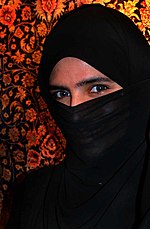Types of hijab
Appearance
| Part of a series on |
| Islamic culture |
|---|
| Architecture |
| Art |
| Clothing |
| Holidays |
| Literature |
| Music |
| Theatre |
This list of types of sartorial hijab indexes styles of clothing found in predominantly Muslim societies commonly associated with the word hijab.
Women
The Qur'an states that women should dress modestly in the presence of unfamiliar men.
| Gulf-style Abaya | 
|
A type of outer garment from the Gulf or Khaleej region of the Middle East which covers from the head to the feet. It is also becoming increasingly common amongst the conservative women of Pakistan. Traditional abayas are black, and may be either a large square of fabric draped from the shoulders or head, or a long black caftan. |
|---|---|---|
| Bushiyya | A veil that is tied on at the forehead and falls to cover the entire face but has no cut-out for the eyes; instead, the fabric is sheer enough to be seen through. | |
| Buknuk | This is similar to khimār 2 (see below) but comes down just to the bosom. Sometimes called "Amira hijab" if it has embroidery at the edge. | |
| Burqa | 
|
Also known as the Afghan Burqa. Covers the entire body and has a grille over the face that the woman looks through. May have slits for the hands. |
| Chador | 
|
An Iranian traditional outer garment that covers the head and body and is a full length semi-circle of fabric but comes down to the ground. Does not have slits for the hands and is held shut with the hands, teeth or simply wrapped under the arms. |
| Hijāb (1) | generic | The entire modest dress of the Muslim woman. |
| Hijāb (2) | generic | The headscarf; this is properly referred to as a khimār, plural khumur. |
| Hijāb (3) | A type of head covering that is a square of fabric folded into a triangle then placed over the head and fastened under the chin; this is probably the most common current style, especially in Western countries. See explanation in the article on Hijāb | |
| Jilbāb (1) | generic | The term used in the Qur'ān (Suratu l-Ahzāb, āya 59) to refer to the outer garment. |
| Jilbāb (2) | A type of outer garment that looks like a long raincoat or trenchcoat. | |
| Khimār (1) | generic | The term used in the Qur'ān (Suratu n-Nūr, āya 31) to refer to the headscarf; the word "hijāb" is more commonly used with this meaning. |
| Khimār (2) | Most commonly, a circular head covering with a hole cut out for the face, which usually comes down to the waist. Note the variations buknuk and chador above, which are the same style but different lengths. | |
| Niqaab | 
|
A veil that covers the face and entire head but with a place cut out for the eyes. |
| Niqaab (2) | 
|
A veil that is tied on at the bridge of the nose and falls to cover the lower face. Also called "half niqab". |
| Paranji | A Central Asian traditional outer garment that covers the head and body, heavy in weight and made from Horsehair. Especially prevalent in Uzbek societies. | |
| Tudung | Headscarf worn in Malaysia | |
| Türban | The headscarf worn in a modern style in Turkey, which is however viewed as a political symbol. |
Men
Men also have to dress modestly.
| Igal | 
|
A part of the headdress for men. Often they are made of a black rope-like cord. They are worn atop the head to help keep the ghutra secured. |
|---|---|---|
| Bisht | A loose robe worn over a thawb. | |
| Iḥrām | The name typically used to denote the clothing worn by a pilgrim during either the Hajj or Umra. For a male, the first part is the izar, a piece of cloth wrapped around to cover from the ankles to the abdomen. The second piece, called the reda, is draped over the shoulders to cover the upper body. The cloth is to be plain, white and unsewn. For women, typical and unpretentious clothes will be their iḥrām. [1] | |
| Kuffiyya, Ghutra or Shmagh | 
|
A checkered scarf often tied with igal. Can be styled into a turban or worn loosely over the head. |
| Taqiyah (cap) | 
|
A crochet cap that covers most of the head. Worn by Arab men. It can also be a round, sewn cotton cap that is embellished with embroidery. In Pakistan,India and Bangladesh it is called a topi. In West Africa, it is called a kufi. |
| Thawb | 
|
Or "thobe", a long, robe-like garment. Often white, symbolizing purity and light. |
| Turban | Cloth wrapped around the head. Turbans are wrapped in varying styles, and often an undercap is worn. |
See also
External links
- BBC drawings depicting different forms of Islamic women's clothing
- All Types of Islamic Clothing
- Different types of Hijab
- List of Hijab types